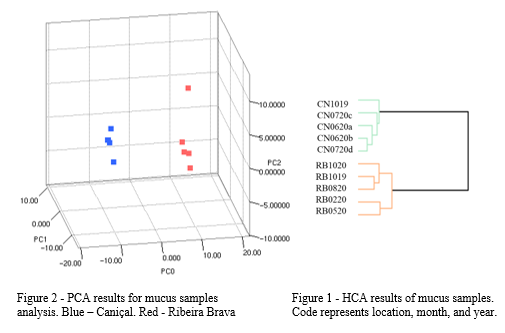MASS FINGERPRINT-BASED APPROACH FOR ORIGIN DISCRIMINATION OF MADEIRA AQUACULTURED Sparus aurata
Introduction:
E ven though considered illegal and several regulatory guidelines are in enforcement, food fraud is still a recurrent prac tice through all food supply chain . In the case of seafood products, missing the identification of species and repackaging of products, constitute the most common frauds . Therefore, the development of appropriate analytical approaches, to be used against food fraud is necessary1. The aim of the present study is to evaluate, for the first time, the possibility to differentiate between fish from two different mari culture farms located in Madeira island, using mass fingerprint of fish mucus combined with multivariate analysis.
Material and Methods:
Sparus aurata mucus was collected at two different farms both explored by IlhaPeixe SA. One located at Baia D’abra , Caniçal (32°44’31.4"N 016°41’26.7"W) , and the other at Campanário , Ribeira Brava (32°39’38.1"N 017°03’22.1"W). A volume between 5-10ml of mucus were collected at fish capture. Mucus samples were cleaned with a chloroform/methanol precipitation method. The aqueous layer and pellet were analyzed using a MALDI-TOF MS. The MALDI full spectra were exported and analyzed using MASS-UP software, for biomarker discovery and multivariate analysis.
Results:
Figure1, is the representation of the PCA analysis results for the data containing samples from Caniçal (blue ) and Ribeira Brava (red). The eigenvalue for the three first components are PC0-395.4, PC1- 63.0 and PC2-60.0. The variances were 0.51, 0.082 and 0.07 8, respectively. The figure 2 shows the hierarchical cluster analysis (HCA) obtained from the analysis of the peaks lists. The results of the agglomerative HCA were expressed as dendrograms, for better results representation. It was also possible to obtain a list of potential biomarkers for each location, a total of 35 peaks with 17 for Caniçal and 18 for Ribeira Brava.
Conclusion:
The results indicate that there are differences between the mass peaks of samples from different origins. The discriminant peaks are good candidates’ biomarkers to differentiate between the two sea farm sites. Further analysis must be done in order to access if the discriminant peaks are still detected at selling points or if others will arise, mostly influenced by the product degradation.
Acknowledgements:
This work was supported by FCT-Fundação para a Ciência e a Tecnologia through the CQM Base Fund - UIDB/00674/2020, and Programmatic Fund - UIDP/00674/2020, and by ARDITI-Agência Regional para o Desenvolvimento da Investigação Tecnologia e Inovação, through the project M1420-01-0145-FEDER-000005 - Centro de Química da Madeira - CQM+ (Madeira 14-20 Program). The authors also acknowledge the financial support from FCT - Fundação para a Ciência e Tecnologia and Madeira 14-2020 program to the Portuguese Mass Spectrometry Network through PROEQUIPRAM program, M14-20 M1420-01-0145-FEDER-000008 ). The authors also acknowledge ARDITI and IlhaPeixe S.A., through the support granted under the M1420 Project-09-5369-FSE-000001 - for PhD grant to Jorge Freitas.
References :
1 Freitas, J., Vaz-Pires, P., Câmara, J.S , Aquaculture., p 734857, (2020 ). https://doi.org/10.1016/j.aquaculture.2019.734857
